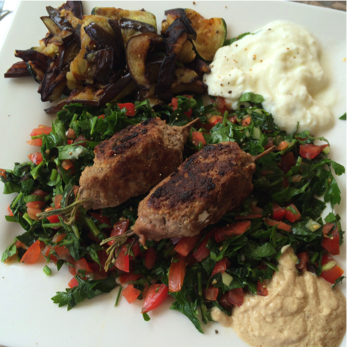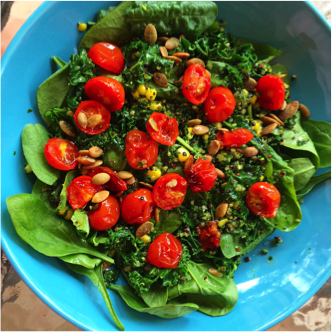Today on our blog we invited local Dietitian/Nutritionist Katrina Mills from Body Fusion to give advice to those hard working woman (who run around all day) some information on the top 4 nutrients every woman should know about. Take it away Katrina……
This blog is for all the hard working ladies out there. The mothers who run around after children of all ages, the hard working women in the workforce, the house cleaners, chauffeurs, accountants.. the list is clearly endless. For so many, time is spent looking after others often at the detriment of their own health. Ladies, it’s time you take some time to look after yourselves, starting with what you’re eating!
There are four ‘top’ nutrients that I’d consider to be key to boosting women’s health in certain areas like increasing energy levels, maximizing bone health and promoting fertility & reproductive health.
Number One – Iron
One in five women in Australia are iron deficient; iron deficiency is actually the world’s leading nutrition deficiency.
Iron is an essential mineral that your cells need for survival. They body cannot make iron and therefore relies upon food to deliver it.
Like all minerals it has many roles, it’s main job though is to help make a protein called haemoglobin. Haemoglobin acts as a ferry and carries oxygen from your lungs to all of your cells. Without enough oxygen your cells aren’t able to produce energy, leaving you without energy as a result!
Women who menstruate heavily, participate in regular athletic training, are pregnant or have absorption issues have increased iron requirements. It is important that you ask your GP for a blood test to determine your iron status.
Eating iron rich foods is one way of improving your iron levels.
There are two types of iron, haem and non haem, both of which are essential to the diet. Haem iron is best absorbed by the body and comes from animal sources whereas non haem iron is found in plant based foods but isn’t as well absorbed.
Iron rich foods to include in your diet:
Haem iron sources:
- 3 -4 serves/week of lean red meat (lamb, beef, kangaroo)
One serve = 80g or small palm size
- 1-2 serves/week of coloured fish (salmon, trout, fresh tuna)
One serve = 150g
Non haem iron sources:
- Wholegrains
- Beans, legumes & lentils
- Dark green leafy vegetables (spinach, chinese broccoli, kale)
- Nuts & dried fruit
Simply eating more iron rich foods may not be enough though, that is why it is important to learn about how to increase iron absorption, particularly if you follow a Vegetarian or Vegan lifestyle, it is recommended you seek specialised nutrition advice – please contact us if you would like to discuss your iron intake.
Number Two – Folate
This B group vitamin is often associated with women because it is particularly important during pregnancy for preventing neural tube defects in infants. Folate is also essential for DNA replication (the production of new codes that tell our cells what to do) as well as for healthy growth and development.
Folate is so important that in 2009 Australia introduced mandatory fortification of bread with folic acid.
The recommended dietary intake (RDI) for women is 400 µg/day and pregnant ladies should consume extra on top of this 1 month before falling pregnant through to the second trimester.
Folate absorption from food is only 50-60%, compared to folic acid supplements that are completely, 100% absorbed. Therefore it is recommended that all women looking to conceive and that are pregnant include a folic acid supplement on top of a diet rich in folate.
Eat a variety of foods that are rich sources of folate including:
- Dark green leafy vegetables like spinach, broccoli & asparagus
- Fruit eg. Bananas, blueberries, strawberries, oranges & avocadoes.
- Beans & legumes, including chickpeas & lentils
- Wholegrains
- Nuts & seeds eg. Sunflower and flaxseeds.
- Yeast extract spread eg. Vegemite
- Fortified bread & cereal products
Women eating 2 servings of fruit, 5 servings of vegetables, a mix of wholegrain breads and cereal products and who incorporate lots of variety within their diet should be able to meet their folate requirements through food alone.
Number Three – Calcium
No matter what the fads claim, Calcium is still an essential nutrient used in the body for muscle contraction as well as formation of bones & teeth. 99% of our calcium is stored in bones, which release calcium when reserves in your blood begin to diminish. Our bodies lose Calcium from the bowel, kidneys and through the skin. Therefore dietary Calcium is needed to replace any losses and protect the Calcium stored in bones. Over time Calcium deficiency leads to reduced bone mass and eventually osteopenia and osteoporosis. A deficiency in Calcium is commonly seen alongside vitamin D deficiency because they both contribute to protecting bone health (more about this later).
Dairy foods are some of the most controversial items in the nutrition world, but they are also the highest and most easily absorbed Calcium sources. (This is different to the absorption of lactose, which occurs in some who do no have enough of the lactase enzyme to breakdown the lactose molecule).
I’ve seen time and time again women cutting out dairy to lose weight but numerous studies have shown that dairy consumption is linked to lower weight maintenance.
How much do you need?
- Ages 18-50 = 1000mg/day
- Ages 14-18 & 51/over = 1300mg/day
Why do they need more?
14- 18 year olds: Peak bone mass is achieved in the early 20s and puberty is the most important time to lay down your bone density.
51/over: During menopause rapid bone loss results as a reduction in estrogen. Normally estrogen products bone mass but this reduces 2-3% per year after menopause. As a result more calcium is needed to reduce the bone loss when estrogen levels are lower.
Eat 3 -4 serves of calcium rich foods per day
1 serve (300mg) calcium =
- 1 glass (250ml) milk or fortified soy, almond or rice milk
- 200g yoghurt (if you would like to find out the best yoghurt to choose read our blog here)
- 40g hard cheese (eg cheddar cheese)
- 120g soft cheese (eg. ricotta, cottage cheese).
- 100g tinned fish with bones (salmon)
- ¾ cup fortified wholegrain breakfast cereal
Green vegetables do contain some calcium, but not in the same quantity or easily absorbed form that would allow you to meet your dietary intake in one day.
Lactose intolerant? Vegetarian or Vegan? – Choose lactose free calcium products like fortified milk, yoghurt and cheese products.
Number Four – Vitamin D
For a country bathed in sunlight you would be surprised how many people have a Vitamin D deficiency. As mentioned earlier, Vitamin D works with calcium to improve bone health. It does this by helping the small intestine to absorb calcium as well as improving the absorption of phosphorous, that the body uses in the formation of new bone.
Why should you worry? Low vitamin D levels over time correlate to an increased risk of fractures, particularly in the elderly. Vitamin D levels are also extremely important during pregnancy because infants from 0-6 months can develop rickets if they don’t have receive enough vitamin D utero. They are also at risk once born due to their lack of exposure to sunlight and low dietary intake.
In case you don’t know there are two types of Vitamin D. The sun is our major source of Vitamin D3, which is created in our skin when in contact with UV rays. Vitamin D2 is version found in a limited range of foods.
Get outdoors and into sunlight. In the summer time aim for 10-15 minutes in direct sunlight with your arms and face exposed. In the winter extend this to 20 minutes and pair with some moderate exercise, like a power walk.
Include foods containing vitamin D:
- Oily fish like salmon, sardines and herrings.
- Eggs
- Mushrooms, once exposed to sunlight (TIP: leave your mushrooms outside for 10 minutes in sunlight before you cook with them)
You can test your vitamin D levels with a blood test from your GP. If you are low then supplementation is an option and can be prescribed by your doctor. They will guide your dosage, as Vitamin D can be toxic if the upper limit of 4000IU+ is exceeded.
Ladies, make the time for your health. You don’t have to be subject to constantly feeling drained, tired and lacking energy. For individualised advice about these key nutrients as well as the adequacy of your diet, give us a call to book an appointment We’d love to get the women of Lane Cove and Sydney feeling their best!
Katrina Mills is an enthusiastic and driven dietitian/nutritionist who was inspired by food and nutrition from a young age. She believes that whole, natural foods should be one of the cornerstones of a balanced, healthy lifestyle that can be enjoyed by all – no matter what walk of life. You can find out more about Katrina here
Body Fusion
Address
221 Longueville Rd Lane Cove, New South Wales, Australia
Phone Number
0410 533 213
Web
Body Fusion
Email
[email protected]
Twitter
@Body_Fusion_
Instagram
https://instagram.com/bodyfusion/


















This is fantastic information. Keep up the good work.
T